
rewrite this content
As we gear up for 2024 SaaStr Europa in London (June 4-5) and SaaStr Annual in SF Bay (Sep 10-12), we wanted to take a look back at one of last year’s most popular sessions: How to Pitch Your Startup with YCombinator’s Michael Seibel.
Any founder you talk to likely remembers every investor who said no to them.
Those founders hold a special kind of “not hatred,” says Michael Seibel, Managing Director and Group Partner at Y Combinator, but a special kind of something for those investors and a desire to prove them wrong.
If you’re a seed-stage startup, Michael shares the best ways for you to present your company to startup investors.
He’ll cover the best tactics to catch investor attention and reveal the secret to standing out.
This is the same advice they give YC companies to become much more successful at fundraising when they’re pre-product market fit.
Michael has done over 2000 YC interviews, and the one thing founders don’t understand is that if investors don’t know what your company does, they can’t fund you.
“The number one barrier to not knowing what your company does is you,” says Michael.
Not the investor or the world or the users or the advisors.
A lot of people think they need to bring a bunch of energy, pizazz, and shark tankyness to a pitch.
You don’t.
You stand out by being concise and easy to understand.
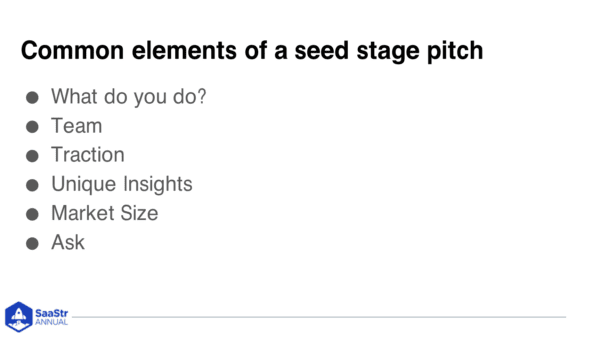

The common elements of a seed stage pitch include:
- What you do
- Team
- Traction
- Unique insights
- Market size
- Ask
What does your company do? Who’s on your team? What’s your traction? What do you know that everyone else doesn’t? What’s your market size? What are you asking for?
That’s it. That’s the pitch. It’s simple. It’s not fancy.
You need to be able to say what your company does in two simple sentences with a specific example.
Let’s use Airbnb as an example.
Two sentence description of what Airbnb does:
They let any home or apartment owner rent out their place online. They collect the payment online and take a 15% fee for every booking.
That’s it.
A lot of the magic comes in the specific example.
Real-world example:
Imagine that you’re a waiter who lives in Washington, D.C. It’s 2009, and the Obama Inauguration is happening in town. Every hotel room is fully booked. You can make $2k-$4k renting out your apartment, and that’s what you need to pay your rent for the next couple of months.
So, you take a few photos of your place and upload them onto Airbnb. Airbnb handles the payments and gets you a guest, and now your rent is covered for the next couple of months.
What’s interesting about that example is it’s specific. You can imagine all of it.
What you don’t see is a vague example, which is where people go wrong.
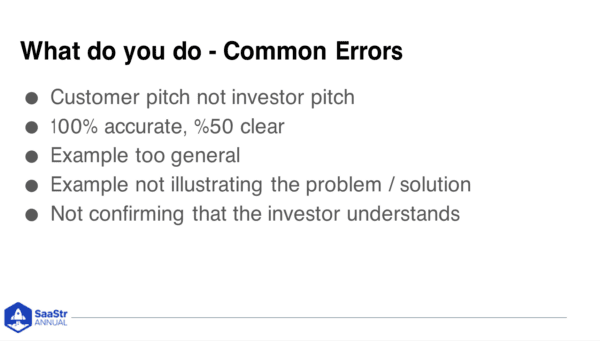

- Customer pitch, not investor pitch
- 100% accurate, %50 clear
- The example is too general
- The example doesn’t illustrate the problem/solution
- Not confirming that the investor understands
Customer pitch, not investor pitch
Often, founders pitch or explain something in a way a customer would understand but not an investor.
Most of the time, the investor isn’t the user. They don’t have the same experience, so you need to use simple language they understand.
You need two different answers for what you do.
- For customers
- For investors
The words on the front page of your website are for customers.
Trying to be 100% accurate
A lot of details are left out of Airbnb’s two-sentence description, but it was clear and easy to understand.
The goal is to be 80% accurate and 100% clear.
The example is too general
The Airbnb example could have said, “If you’re in a place with a big event and need to pay your rent, you can rent your place out and pay your rent.”
That’s very vague, has none of the facts, and doesn’t stick in your memory.
The example doesn’t illustrate the problem/solution
It’s inherent that a waiter or waitress doesn’t make a lot of money. You don’t have to have a complicated problem/solution slide.
Not confirming that the investor understands
Many founders screw up if they leave the first slide of the presentation and the investor doesn’t know what they do.
If your first slide is a nice logo and you’re saying a whole lot of nothing, and then you move on, investors will have no idea what your company does before they’re looking at charts and graphs.
Don’t do that.
How do you make sure the investor understands what you do?
Ask them.
Do you have any questions? Would another example be helpful to understand what we do?
The purpose of the team slide is to talk about who is on your team, what they do, what their impressive accomplishments and credentials are, and, if possible, how they’ve personally experienced the problem.
Let’s go back to Airbnb.
They could talk about how they were starving startup founders who couldn’t pay their rent.
That the first time they did this, they set up a website for a design conference, hosted three guests, and paid their rent.
If you can weave how you’ve experienced the problem into the team slide, suddenly, investors think of you as an expert.
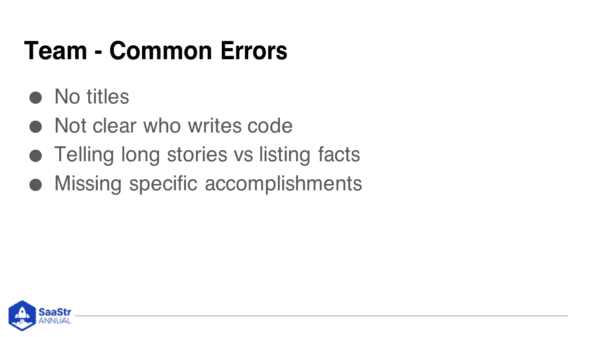

Common Errors for the Team Slide
- No titles
- Not clear who writes the code
- Telling long stories vs. listing facts
- Missing specific accomplishments
The first two errors are pretty obvious. Be clear about who does what on your team.
Telling long stories vs. listing facts
The team slide isn’t the opportunity to tell your life story.
A hint from Michael: There is no opportunity to tell your life story unless they specifically ask for it.
And even then, you should double confirm they want to hear it.
Missing specific accomplishments
One company in Michael’s current batch worked on the Mars Rover, but they didn’t talk about it. It wasn’t until a month or two into the project that he learned about it.
If you’ve done something cool, say it without the life story.
I worked on the Mars Rover. That’s impressive.
The traction slide, if you have it, should be a clear explanation of what you’ve accomplished since you started.
Use a graph only if it’s impressive.
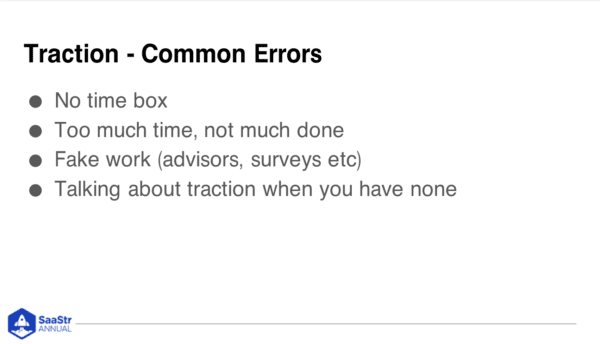

Common Errors for the Traction Slide
- No time box
- Too much time, not much done
- Fake work (advisors, surveys, etc.)
- Talking about traction when you have none
No time box
The only way to communicate whether you’ve done something quickly is if the traction slide includes how much time you’ve spent doing it.
The biggest mistake YC founders make is that they don’t give a time frame of how long the thing they did took.
Without time, it’s not impressive.
Too much time, not much done
All traction is communicating what you’ve done since you started and why that’s impressive.
If you’ve built an IOS app and it’s in test flight in the hands of 100 users in one month, that’s impressive.
On the flip side, if you’ve built an IOS app and it’s been two years and in test flight with 100 users, that’s not impressive.
Investors are looking for momentum, and if you get things done quickly. That doesn’t necessarily mean they care about a ton of users or revenue, although they like that, too.
Fake Work
Don’t share work that’s not furthering the company.
Talking About Traction When You Have None
You don’t need a traction slide if you don’t have any traction. A bad traction slide is worse than no traction slide. If this is week two of your startup, you probably don’t have any traction.
Don’t include it. Talk about the team instead.
What are the non-obvious things you’ve learned about the problem, customer, or potential solution?
This is the most intellectually interesting part of a pitch, and you only get the right to do this if the investors know what your company does and are impressed with your team.
A lot of founders try to skip to this point, but if founders don’t know what your company does, they won’t be able to tell if your insights are good or not.
Let’s look at Airbnb again.
All other products that came before Airbnb didn’t process payments. As a result, hosts and guests weren’t booking because processing payments in a low-trust environment is scary.
If a 3rd party stands in the middle, both can trust the 3rd party more than each other.
If Airbnb said this before mentioning what Airbnb does, it wouldn’t make sense or matter.
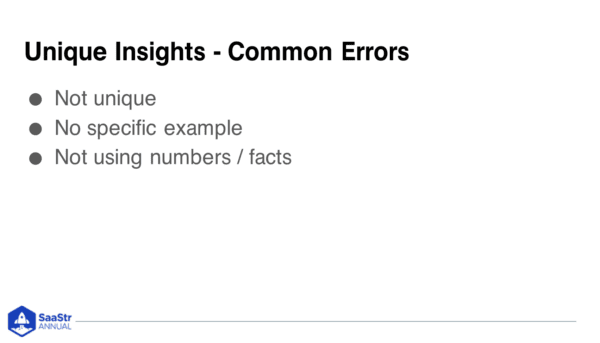

Common Errors for the Unique Insights Slide
- Not unique
- Not a specific example
- Not using numbers or facts
Not unique
If you were to run a survey and 50% of the people in a room knew the answer, it’s not unique.
Not a specific example
This is another place where vagueness comes in with founders. Tell a story about how you gained your unique insight.
Not using numbers or facts
Talk about unique insights from users. Quote numbers and facts. It makes it feel more real.
Everyone screws this up and thinks the number is important.
How big the market is is what’s important.
How you calculate the number is important — a bottoms-up calculation multiplying the number of customers by the revenue/customer/year.
Investors don’t know how many potential users you might get, so educate them about it. Do the research.
Investors don’t know how much you’ll charge users, why you’ll charge them that amount, if they’re buying other products, or how much value you’re creating.
If you teach them that in a pitch, they’ll think you’re an expert, and investors want to fund experts.
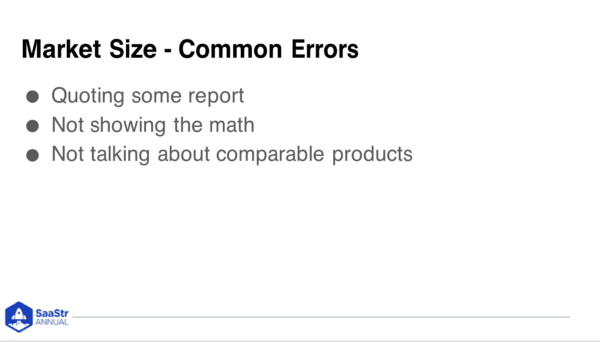

Common Errors for the Market Size Slide
- Quoting some report
- Not showing the math
- Not talking about comparable products
“JP Morgan said that the online eCommerce market is $120 trillion…” Who cares? You aren’t teaching investors anything.
If you’re going to replace Figma and your pricing is competitive, tell them that.
Figma charges this much, and you’re going to charge this much. Or you’ll charge more and provide more value, and this is how.
Throw in a comparison to understand why the price is that price.
This is a really interesting one. How much are you raising, and what milestone will you accomplish with that raise?
In your pitch, you have to ask for money.
You’d be shocked at how many pitches people do, and they don’t ask for money.
Michael guesses around 70% of pitches where the founder asks if there are any questions, the investor says no, the meeting ends, and no one asks for money.
As an angel investor, Michael says there are three mindsets when listening to a pitch.
- “I will never fund this company.” (Most common.)
- “I will definitely fund this company.” (Least common.)
- “If they ask me for money, it will be uncomfortable for me to say no, so I’ll write them a check.” (People don’t talk about this one.)
Michael says up to 10% of the time, he’s hoping a founder doesn’t ask for money because instead of saying no, he’ll say yes because the pain of saying no is worse than writing a $25k check.
The only way to tap into that is to ask. Put them on the fire.
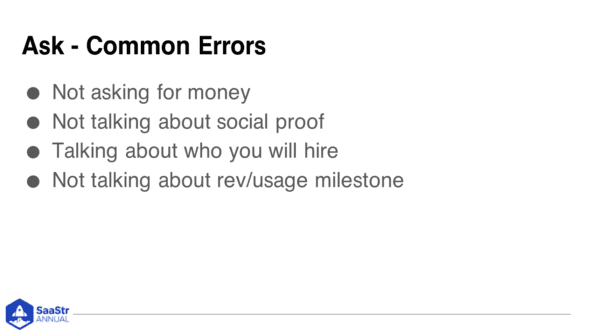

Common Errors for the Ask Slide
- Not asking for money
- Not talking about social proof
- Talking about who you will hire
- Not talking about revenue/usage milestones
Don’t talk about who you will hire on the ask slide. No one cares who you will hire. They care what you will do with the money and what revenue or usage milestones you’ll hit with the money.
Hiring is a means to an end, and that end is revenue and usage.
We’ve gone through the individual elements, so let’s look at the common pitch mistakes overall.
- Not ordering points from most to least impressive
- Not using the presentation to start a conversation
- Not paying attention to the investor
- Distracting slides
Not ordering points from most to least impressive
You can mess around with the pitching format given here.
“What you do” should be at the beginning and “the ask” at the end, but the elements in the middle should be ordered from the most impressive to the least.
If you have a ton of traction, that should come right after the “what you do” slide.
If you have an amazing team, same thing.
People make the mistake with these decks that there’s some super standard format they can’t leave. There’s flexibility, so make the most important points early.
A lot of people think investors will sit for a 30-minute meeting. That’s not true, especially on Zoom.
You earn every two minutes of that meeting.
Don’t leave the good stuff too late. After “What you do,” put the best stuff right after to earn the next two minutes and the next two minutes.
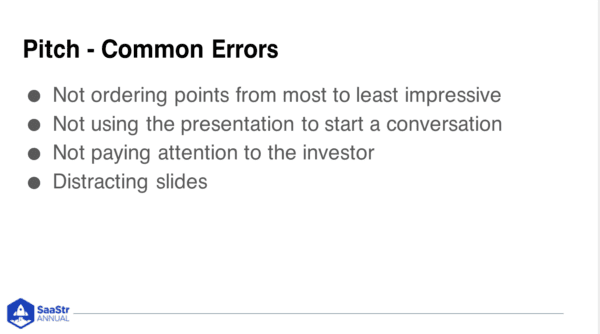

Not using the presentation to start a conversation
Don’t treat a pitch like delivering a book report.
Ideally, your pitch should be a way to draw investors into conversation. This is a hard skill to learn.
It’s easier to deliver the pitch and ask for the grade.
But you aren’t convincing the investor to invest. They’re convincing themselves to invest, so the more they can talk, the more they can talk themselves into giving you money.
If you’ve done sales, the common technique is to look at call recordings to see how much time the customer was talking vs. sales.
If they’re talking 50% or more of the time, they’ll probably buy.
Anytime you see a peak of interest in any part of your presentation, run with it. Get them talking. If they seem interested in the 3rd or 4th slide, skip everything and go straight to it.
Because the more they contribute ideas and make their own connections about why it works, the more they convince themselves to give you money.
Not paying attention to the investor
A lot of pitches are on Zoom. You have a close-up of their face, and if you look at it, you can tell whether they’re interested or not.
Investors have a ton of tells. They’re not poker players with sunglasses on. Their face is an open book if you’re looking.
Distracting slides
You want boring basic slides. If they’re visually interesting, investors will be focused on the slides and not on you.
If you need a designer to build a slide deck, you’re doing it wrong.
Plus, your designer has no idea what the most important points of the pitch are, so they may emphasize the wrong things.
This is your business, and you know what’s important.
If you’re a seed-stage startup looking to fundraise, you want your pitch to be clear, concise, impressive, and simple. That’s the game.
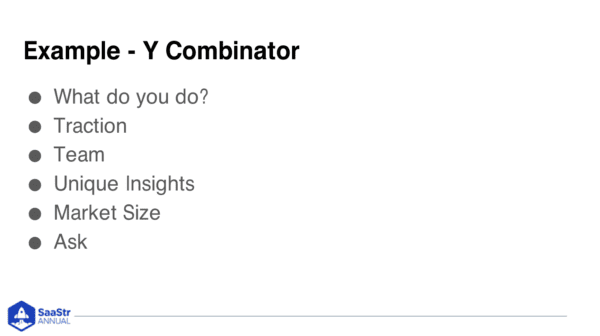




Leave a Reply